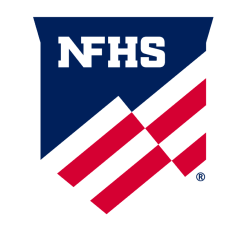The NFHS Voice

 The NFHS Voice
The NFHS Voice
NFHS Rules-Writing Task Continues with Focus on Sportsmanship, Minimizing Risk
Dr. Karissa L. Niehoff, NFHS Executive Director
During the past 15 years, the National Federation of State High School Associations (NFHS) has initiated several programs that have made a significant impact on education-based activity programs across the country.
The NFHS Coach Education Program was started in 2007. With its expansion to students, parents, administrators, officials, music directors and adjudicators, and others, the NFHS Learning Center has now delivered more than 15 million courses online through its website at www.NFHSLearn.com. About 90 courses are now available, including more than 60 that are free, and the Concussion in Sports course has been taken by more than six million individuals.
In 2013, the NFHS Network was started as a first-of-its-kind, all-digital high school network providing live coverage of high school events at www.NFHSNetwork.com. In its ninth year of providing coverage of high school sports, performing arts and other activities, more than 500,000 events and more than 30,000 post-season events will be covered. Through its ever-increasing coverage, the NFHS Network has become the largest destination for high school sports broadcasts in the country.
These two ventures, as well as expanding services and programs for students involved in the performing arts programs, have been developed during the 102-year history of the NFHS to assist schools and state associations; however, none have been more enduring and important than the chief task of the organization since its formation in 1920 – writing playing rules for high school sports.
The NFHS began its role as the rules-writing body for high school sports in the early 1930s with the first high school rules for football, followed by basketball and track and field. Today, the NFHS writes playing rules in 17 sports for boys and girls.
During the past few months, the annual rules-writing process began as rules committees in the sports of football, volleyball, field hockey, soccer, swimming and diving, and spirit met to discuss the state of those sports and any potential rules changes for the coming season. In addition, the NFHS writes playing rules in the sports of baseball, basketball, cross country, girls gymnastics, ice hockey, boys lacrosse, girls lacrosse, softball, track and field, water polo, and wrestling.
This year, as has been the case since the NFHS became involved in this important task, the rules-writing process is being conducted with a three-pronged focus: 1) minimize the risk of injury, 2) maintain sound traditions of the sport, and 3) encourage sportsmanship.
With almost eight million participants in high school sports, NFHS rules are written for more individuals than all other levels of sports combined. As a result, risk minimization and the fundamentals of good sportsmanship are paramount to the rules-writing process for the NFHS and often are the distinguishing factors from rules at the higher levels of the sport.
Perhaps football is the best example of the commitment to risk minimization. In the mid-1970s, the NFHS was at the forefront of change when it outlawed spearing in high school football. The 1976 rule revision changed the landscape of high school football from an injury standpoint – from a high of 36 direct fatalities in 1968 to an average of about two per year by 2018.
Some people have questioned why there are multiple rules codes for a sport. Very simply, NFHS rules for high school play must be different than at the college and professional levels.
As an example, while professional baseball is concerned with how fast a baseball exits the batter’s box (Velocity Exit Speed) and how far the ball travels on a home run, the NFHS has enacted bat standards during the past 20 years to reduce the speed of balls coming off aluminum bats. In wrestling, the NFHS has enacted strict weight-management plans to reduce the risk of health issues. In football, NFHS rules do not permit the excessive celebration displays following touchdowns that occur during NFL games.
In addition to risk minimization and sportsmanship, the NFHS must also weigh financial implications for schools when considering equipment and uniform changes. With schools ranging in size from less than 100 to more than 5,000 students, decisions must be made for the masses and cannot put undue financial hardships on schools.
NFHS rules are also written with the understanding that appropriate behavior begins with the coach, who is responsible for ensuring that his or her team exhibits good sporting behavior. Many penalties for unsportsmanlike conduct on the team are first directed against the coach.
Now in its 90th year of writing playing rules for high school sports, the NFHS continues in its devotion to minimizing risk of injury, sportsmanship and maintaining the sound traditions of the sport.
Dr. Karissa L. Niehoff is in her seventh year as chief executive officer of the National Federation of State High School Associations (NFHS) in Indianapolis, Indiana. She is the first female to head the national leadership organization for high school athletics and performing arts activities and the sixth full-time executive director of the NFHS. She previously was executive director of the Connecticut Association of Schools-Connecticut Interscholastic Athletic Conference for seven years.









